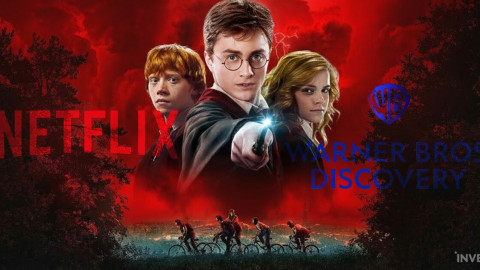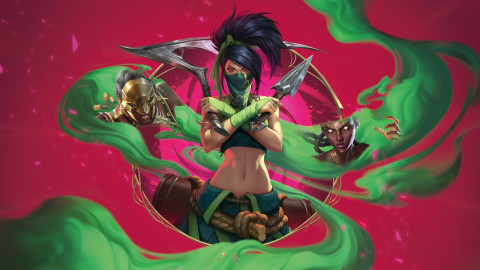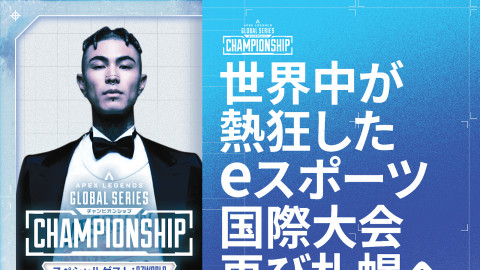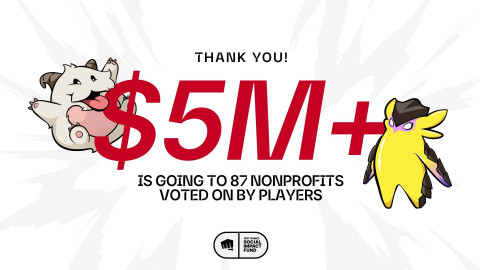
Earlier this week, the kind people of Cheddar Esports invited me to come on their show and discuss Teamfight Tactics as it heads into 2020. Riot’s game mode has been the leading autobattler for the past few months, so naturally there is curiosity about its prospects. On the show I discussed several topics including how TFT compared to other autobattlers, where it falls in Riot’s plan for the other games they’re announcing, and what the impact of TFT’s mobile client could be.
But there was one topic that resonated with me most: “What will 2020 look like for competitive Teamfight Tactics?” After all, in September last year, Riot Games literally said: “We’re committing to building a competitive scene for TFT starting in 2020. The hunger is definitely there—the proportion of ranked to normal games of TFT is 4:1, and the mode is incredibly resonant in some of our most competitive regions like Korea. We want to provide an experience worthy of the players that have dedicated themselves to being the best in the world.”
The question provoked an idea I’d had late 2019, but that had been buried under other projects since. Just as it did then though, the landscape of competitive TFT looks barren now. On the Cheddar Esports show I could only give a brief summary of my thoughts—perfectly understandable given the show’s format—so if you want to have a summary, or hear me talk about those other subjects, head over to the VOD.
In this article I’ll give a more thorough breakdown of the state of Teamfight Tactics esports at the moment, and analyze the barriers I see that are holding its development back.
Let’s first look at the notable Teamfight Tactics tournaments that have been held so far. Esportsearnings.com lists a total of six tournaments with a prize pool over $10,000 USD, led by the $150,000 Red Bull Rise of the Elements Invitational. In total, it lists seven tournaments, but that’s deceitful: the TFT Road to TwitchCon tournament was part of the TFT TwitchCon 2019 main event. When we look critically at those tournaments, there is an easy trend to spot: they’re mostly personality-focused.

The Twitch Rivals events are and have always been trivial competitions where fan favorite streamers get some extra exposure in a booming title. Then we have TFT Thursday, a one-time event hosted by Imane “Pokimane” Anys for competitors selected by her, another invitational by Plus 1, and the aforementioned Red Bull Invitational. No, the most ‘open’ big tournament in TFT so far has been the TFT TwitchCon tournament. It featured an online qualifier and an on-site qualifier for aspiring Teamfight Tactics professionals. The main event, however, was still headlined by twelve invited personalities, who joined the players that had fought their way up to that final stage.
There’s nothing fundamentally wrong with holding invitational tournaments, of course. It’s a great way to generate interest in a budding esports title, and enthuse others to give the game a try, and perhaps inspire them to participate in its competitive scene. But if players don't have a route to work their way to the top based on their skills, they'll eventually leave.
For a game mode released in June, published by the creator of the world’s biggest esports title in League of Legends, remarkably little interest has been shown by third party organizers to host big events. And on a grassroots level, it’s tough to find a sizeable community, or at least one that meets the expectations given the hype that surrounded autobattlers for a large part of 2019.
Part of the blame is probably on Riot Games themselves. Whenever a new, potentially competitive title takes off, it's fair to assume all big tournament organizers keep an eye on it, drafting ideas for a tournament structure they could build potentially around it. But as ironic as it may sound, when in September 2019 Riot announced that they’d be investing in TFT esports in 2020, those organizers probably stopped and held their breath. And perhaps they had been holding their breath ever since Teamfight Tactics was announced.
The reason for what seems to be a contradiction is fairly simple. Riot managed to build League of Legends into the most-watched esport of the planet, but they did so by completely taking control of it as a company. All the large League of Legends competitions are run by Riot themselves. There is no room for anyone else in there.
Typically, tournament organizers invest in an esport hoping to become a household name. Sponsors don’t strike deals with tournament organizers for a one-time event, but bet their money that the brand they have invested in will become one of the largest tournament organizers within an esport, guaranteeing repeated exposure for the sponsor. But if you’ve got yourself a good first tournament, perhaps even two, done, and all of a sudden Riot takes full control over TFT esports like they did with League of Legends, your plans are gone. And gone is a valuable sponsor for potential future events in other titles.
So as a tournament organizer eyeing the potential of Teamfight Tactics as an esport, what do you do when Riot not only announces a new title, but also that they’ll be investing in its esports scene, just months after said title is released? You wait.

The fear of such a chokehold isn’t unprecedented. Back in my days as a writer for GosuGamers, the website jumped on the Overwatch hype train as soon as it entered Closed Beta. The grassroots-focused GosuGamers Weeklies were the first repeating grassroots events and attracted players who would eventually star in the Overwatch League, and it was at the GosuGamers Weeklies where two of the title’s most well-known casters, Robert "hexagrams" Kirkbride and Andrew "ZP" Rush, honed their Overwatch casting skills.
The Overwatch community grew steadily and in a healthy fashion, with the Weeklies as one of the most active grassroots events, until Blizzard announced the Overwatch League. Teams and large tournament organizers abruptly stopped to evaluate the situation of a competition of which the details were completely shrouded. There was doubt and uncertainty, which businesses don’t tend to appreciate. They want a certain plan for profit. The announcement stagnated the development of Overwatch’s competitive community, the ripples of which can still be felt today as Overwatch struggles to find new talent to compete and to cast. The organizations' fear became true, and now Blizzard has competitive Overwatch in a complete chokehold. They control every aspect of top tier Overwatch, dictating how and when it’s allowed to breathe.
League of Legends developed in a far more healthy fashion in its early days, and had an established community as Riot began to develop competitive structures. The strength of Riot’s grip on competitive League of Legends nowadays is similar to that of Blizzard on Overwatch’s esports scene and there is a lot to be said about Riot’s approach to competitive League of Legends, but that hold wasn’t applied as abruptly as Blizzard's. Riot built up to it, feeling out what did and what did not work well.
Tournament organizers will look at the current status however, when evaluating whether or not to venture into TFT esports. And what they see is that Riot has its largest esports esports mostly pinned down. They wonder: "Will the same eventually happen to Teamfight Tactics esports?"
I’ve extensively painted why I think the landscape of large, third party Teamfight Tactics tournaments is so dry, and what Riot’s role in it is. But of course, this doesn’t explain yet why the grassroots community isn’t vibrant. Smaller-scale tournament platforms know that their place in the industry isn’t at the top, in the spotlight: they attract the aspiring pros and are the first step on the stairway to stardom. As said earlier, though, that grassroots community is, for a Riot Games title and a genre that exploded in popularity in 2019, awfully quiet.
I can’t simply and directly point the finger at Riot Games here. If a game is fundamentally fit for esports, there will be a thriving community that keeps itself alive, whether they’re backed up by the game’s publisher or not. Especially in this day and age, where finding an active community is one click away, and the tools to host competitions are in abundance. A prime example of a game fundamentally fit for competition with a strong grassroots core is Super Smash Bros. Melee. Though Nintendo has neglected its competitive scene since its inception, the title has withstood almost two decades, continuing to build an audience and establishing a legacy. Other examples could be StarCraft, or Counter-Strike. Valve does acknowledge and is, albeit minimally, involved in CS:GO’s esports scene, but the community would not die at all if Valve pulled back entirely.
So if we want to understand why TFT’s grassroots hasn’t taken off yet, we have to be critical about its fundamentals. Is Teamfight Tactics, fundamentally, a game fit for esports?
I want to quickly dismiss the notion that it can’t be an esports title because of the RNG inherent to it through its itemization system and how you acquire champions in the game. The skill you’re primarily testing in autobattlers is risk assessment. As can be seen when looking at data of Hearthstone and Magic: The Gathering, which test the same skill in a different way, the great players in those titles do boast the same consistency in their prime as top competitors in titles with less RNG. The key for developers is to properly balance the RNG, and for esports it is to find a competitive system that highlights the consistency.
No, by ‘fundamentally’, I’m referring mainly to the depth of the autobattler genre. They have the most similarity with deck-building games (think of the physical game Dominion, or the Slay the Spire on PC). The pool of cards, however, is quite slim. There are just under 60 champions in Teamfight Tactics. Most champions have only two synergies, limiting the amount of champions they have good synergy with. Which lineup combinations work well tend to be figured out relatively quickly, and there is little room for innovation.
The same goes for the items in the game, which are a necessary addition to make each game feel fresh even in a stale composition meta. Players will naturally quickly find out which items do work well and use them to achieve a victory. It loops back to something I’ve already pointed out: developers need to properly balance the RNG in a game like this. When the meta is stale in a card game, players can bring counter decks. In Teamfight Tactics, when you want to counter the perceived strongest lineup, you can do that, but you’re very reliant on finding the right items to work with your composition. If you don’t, you have to settle for something suboptimal, and probably will not win. It’s an incredibly difficult thing to balance, perhaps even an impossible one.

I started this ‘fundamentals’ section by zooming in on the grassroots, and whether or not TFT is fit as an esports. But I’ve only focused on the player perspective, and it’s also important to look at the perspective for tournament organizers and viewers. So far, Teamfight Tactics doesn't have a spectator mode. It's not a major deal for big tournament organizers—they can work around it by tapping into each player's screen—but for grassroots events it's quite a big deal, as they don't have these resources.
Teamfight Tactics, like all the famous autobattlers, is played in a 1v1v1v1v1v1v1v1 format. In a competitive environment, it has a lot in common with battle royale games like Fortnite and PlayerUnknown’s Battlegrounds, where the tournament and viewers have to keep track of many parties fighting for victory. With the invitationals TFT has had so far, viewers mostly could tune into their favorite streamers’ personal stream to follow their adventures in the tournament. But should Teamfight Tactics grow as an esports title, that will no longer be an option. Then it’s up to the casters to tell the story.
Creating a narrative for eight players simultaneously is a nearly unmanageable task in a title like Teamfight Tactics. Unlike battle royales, which is hard to cast but where at least some play-by-play casting can be done on the spot and in-depth analysis can be left an analyst desk, good casting for autobattlers, like for card games, is highly analytical of itself already. Since the players are dancing around randomness, it’s up to the casters to explain to an audience why a lineup is being built a certain way, why champions are positioned the way they are, and why item X is on champion Y. And they have to do that eight times to create a narrative for all the competing players, if they want the audience to properly understand why the best players keep performing well consistently.
John Needham, the Head of Esports at Riot Games, elaborated in an interview with The Shotcaller that TFT esports would be more casual, more entertainment focused. There will be more invitationals and charity events, so we’d best prepare to see more streamers appear in tournaments.
For now, I hope that the autobattler genre as a whole goes back to the evolving state it was in for the largest part of 2019. There’s no doubt that more publishers will eventually release their take on autobattlers, and bring innovations with it. If Riot is willing to continue to push the boundaries of Teamfight Tactics, and expand the game into a full-fledged game experience, then TFT’s competitive scene has enough time to continue growing. Games like Rocket League and Rainbow Six Siege started with relatively small competitive communities, but have improved and expanded as an esport year after year. For TFT time hasn’t run out yet, but the clock will not stop ticking.
It’d be a shame if no competitive structure will develop over time for Teamfight Tactics, where the up-and-coming can work their way through to the top, and if it’d just be a popularity contest of showmatches. There is potential in Teamfight Tactics, and in the autobattler as a whole, to grow a decent-sized, true competitive community. But it may very well be that the genre never reaches that state. At the moment, we rely on TFT’s developers and their vision for the game. Riot has the cards in their hand. Let’s see if they’re willing to play them.
Images via Riot Games
-

Storyteller by heart. If something is competitive, I am interested in it.
Sort by:
Comments :0





